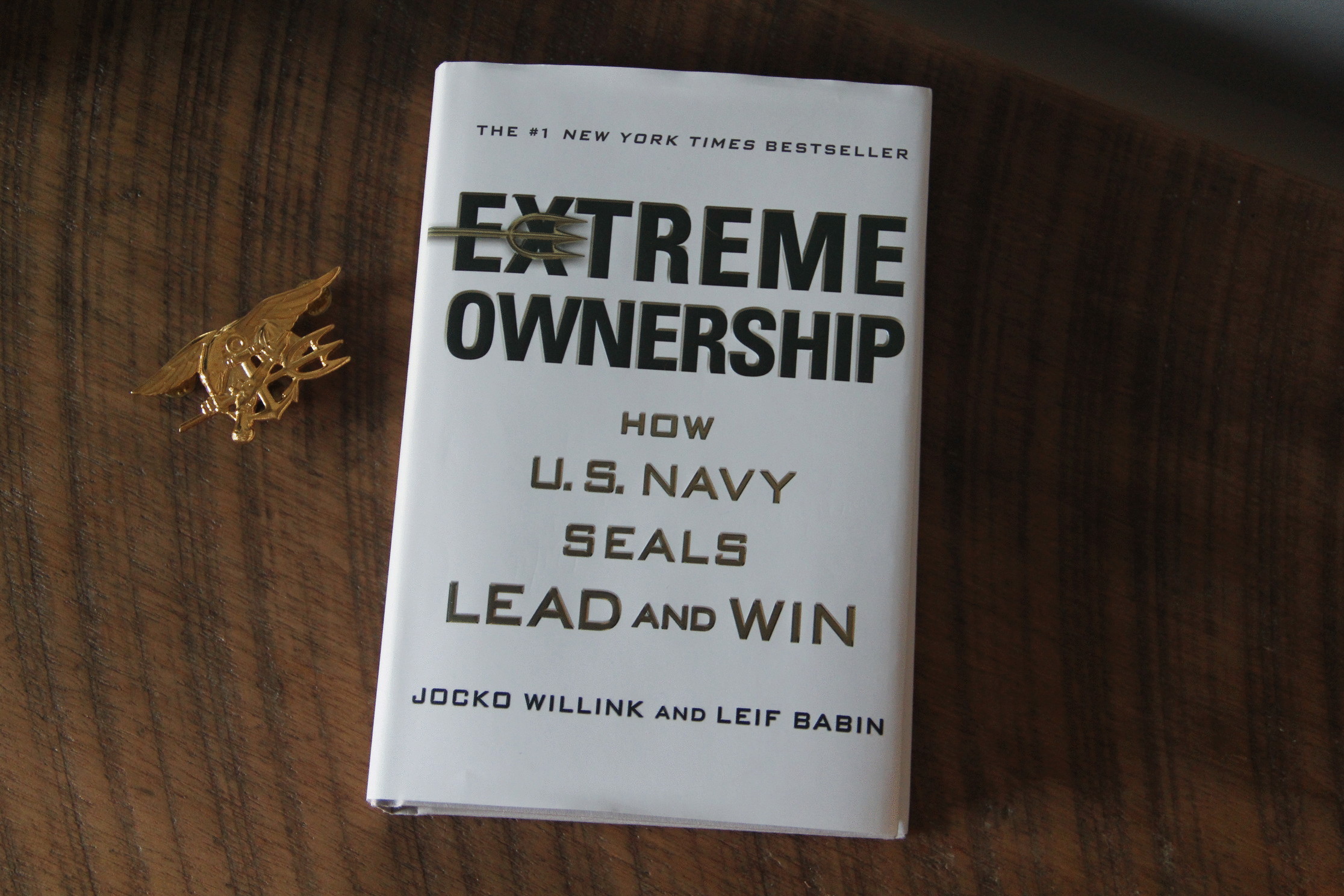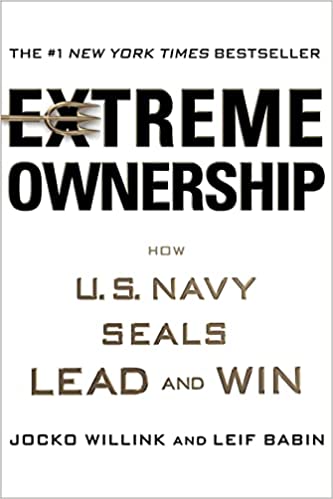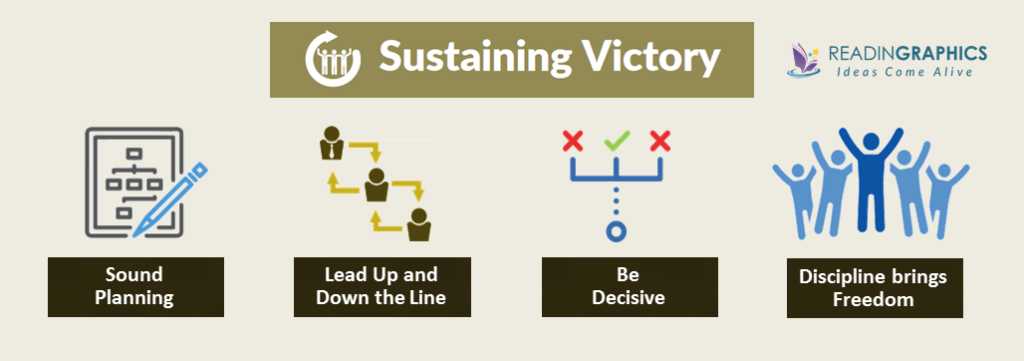
Extreme Ownership:
How US Navy SEALs Lead and Win

Lessons on leadership from two Navy SEALs – be accountable for everything in your world, set clear and simple objectives, and empower others.
Author: Jocko Willink and Leif Babin
Topic: Leadership
Print | Audiobook | Ebook |
On this page:
- ⭐ Key Notes
- Chapter 1: Extreme Ownership
- Chapter 2: No Bad Teams, Only Bad Leaders
- Chapter 3: Believe
- Chapter 4: Check the Ego
- Chapter 5: Cover and Move
- Chapter 6: Simple
- Chapter 7: Prioritise and Execute
- Chapter 8: Decentralised Command
- Chapter 9: Plan
- Chapter 10: Leading Up and Down the Chain of Command
- Chapter 11: Decisiveness and Uncertainty
- Chapter 12: Discipline Equals Freedom
- 📹 Video Summary
⭐ Key Notes
- Accept total responsibility for everything in your world.
- Make plans simple and communicate clearly.
- Be comfortable making decision with incomplete information and adapt accordingly.



Chapter 1: Extreme Ownership
- All responsibility for success and failure rests with the leader.
- Accepting responsibility for failure requires humility and courage.
- Look at problems through an objective lens of reality, without emotional attachment to agendas or plans.
- Effective leaders do not take credit for the team’s success – bestow the honour upon the team members.
- How can I best get my team to most effectively execute the plan in order to accomplish the mission?
- Pointing fingers and blaming others is easy and contagious.
- Actions of the leader create the culture – subordinates emulate actions.
- If something is not going your way, start with what you are going to do differently.
Chapter 2: No Bad Teams, Only Bad Leaders
- A leader’s attitude sets the tone for the entire team.
- If substandard performance is accepted and noone is held accountable – poor performance becomes the new standard.
- Never be satisfied – always strive for improvement and build that mindset into the team.
- Negative attitudes are infectious.
- An attitude of victimisation prevents you from looking inwardly at where you have the ability to improve.
- Tortured genius – people who accept zero responsibility for mistakes, make excuses, and blame everyone for their failings.
Leaders must accept total responsibility, own problems that inhibit performance, and develop solutions to those problems.
Chapter 3: Believe
- To convince and inspire others, a leader must be a true believer in the mission.
- If you do not understand or believe in the decisions coming from above – ask questions until you understand how and why those decisions are being made.
- A leader that does not believe in the mission will not taje the risks required to overcome the inevitable challenges.
- Understand that you are part of something greater than yourself.
- Every leader must be able to detach from the immediate tactical mission and understand how it fits into strategic goals.
- Start with why – if the troops understand why, they will engage and move forward.
- It is the responsibility of the subordinate to reach out and ask if they do not understand.
Chapter 4: Check the Ego
- Ego can be good when it drives high-performance and success.
- When ego clouds our judgement and prevents us from seeing the world as it is, then ego becomes destructive.
- Accept constructive criticism.
- When personal agendas become more important than the team – failure ensues.
- Operate with a high degree of humility.
- Ego does not like to accept blame.
We cannot ever think we are too good to fail, or that our enemies are not capable, deadly, and eager to exploit our weaknesses.
Chapter 5: Cover and Move
- Cover and move = teamwork.
- Each member of the team is critical to success.
- The efforts must be clearly defined.
- Groups within the team must depends on each other and understand who depends on them.
- One team covers, while the other team executes.
Chapter 6: Simple
- Life has inherent layers of complexity – simplify as much as possible.
- Plans must be communicated in a manner that is simple, clear, and concise.
- If your team does not understand – you have failed to keep things simple.
- Ensure that the lowest common denominator of the team understands.
- Teams cannot intelligently adap to chanes without understanding the original plan.
When things inevitably go wrong – complexity compounds the issues that can spiral out of control into a total disaster.
Chapter 7: Prioritise and Execute
- Relax. Look around. Make a call.
- Remain calm, step back from your immediate emotional reaction, and determine the greatest priority for the team.
- If you try to take on too many problems simultaneously – you will likely fail them all.
- Junior leaders often take on more than they can handle.
- Determine the highest priority tasj and execute one at a time.
- You will be more effective under pressure if you plan for contingencies.
- Map out a response to anticipated challenges before they happen.
- Take a step back and maintain the strategic picture.
- Ensure clear communicate up and down the chain of command when priorities change.
- Be careful to avoid fixation on a single issue.
- Maintain the ability to adapt rapidly to changing environments.
Chapter 8: Decentralised Command
- We are generally not capable of effectively managing more than 6-10 people.
- Every leader must understand what they are doing and why.
- Leaders must be free to move to where they are needed most.
- Be proactive, not reactive.
- Leaders exist at all levels.
- Junior leaders must:
- be empowered to make decisions to accomplish the mission – in the most effective and efficient manner possible.
- know the limits of their decision-making authority.
- pass critical information up the chain, so that senior leaders can make informed strategic decisions.
- have implicit trust that senior leaders will back their decisions.
Chapter 9: Plan
- A broad and ambiguous mission results in lack of clear focus, ineffective execution, and mission creep.
- Every mission must have a clear purpose and outcome.
- Delegate the planning process down the chain as much as possible.
- Give troops ownership – let them buy into the plan.
- Plans must be communicated in a simple, clear, and concise format.
- Encourage discussions, questions, and clarification.
- Mitigate identified risks where possible.
- Focus on areas that can be controlled – do not get caught up worrying about risks that cannot be mitigated.
- Debrief and analyse after execution.
- Address what went right, what went wrong, and how you can adapt to be more effective in the future.
- The planning process should be standardised and repeatable
Plan checklist
- Analyse the mission
- Understand the higher strategy, purpose, and desired outcome – what, why, hoiw.
- Identify your own purpose and expected outcome.
- Identify personnel, assets, resources, and time available
- Decentralise the planning process
- Empower key leaders to analyse the best possible course of action.
- Determine a specific course of action
- Lean towards the simplest plan.
- Focus efforst on the best course of action.
- Empower key leaders
- Plan for likely contingencies
- Mitigate risks that can be controlled
- Delegate portions of the plan to junior leaders
- Continually check and question the plan against emerging information
- Brief the plan to all participants
- Empasise the why
- Ask questions.
- Engage the team to ensure they understand.
- Debrief after execution
Chapter 10: Leading Up and Down the Chain of Command
Leading down:
- Clearly explain how their role contributes to big picture success.
- The troops must be able to connect the dots – between their responsibilities and the strategic goals.
- Observe the frontline in action.
Leading up:
- Examine what you can do to better convey critical information up the chain.
- In the absence of authority – use influence, experience, knowledge, communication, and maintain professionalism.
- Understand that you may not be the priority right now – your boss has limited time and resource.
- Support your boss.
- Talk positively about those in authority above you.
- A public display of discontent or disagreement undermined the authority of a leader.
- Once a decision has been made – execute the plan as if it were your own.
Key factors:
- Take responsibility for leading everyone in your world.
- If someone is not doing what you want – look in the mirror first and determine how you can better enable action.
- Do not ask your leader what you should do – tell them what you will do.
Chapter 11: Decisiveness and Uncertainty
- There is never a 100% correct solution.
- The picture is never complete.
- You need to be seen as decisive and willing to make tough choices.
- Intelligence gathering is important, but must be employed with realistic expectations.
- Utilise previous experience, knowledge, likely outcomes, and whatever intelligence is available in the moment.
Leaders must be comfortable with uncertainty and make decisions promptly. Then, be ready to adjust those decisions quickly based on evolving situations and new information.
Chapter 12: Discipline Equals Freedom
- Freedom to operate and manoeuvre increases through inner-discipline.
- Leaders must never put their own drive for personal success ahead of the greater team and overall mission.
A good leader must be:
- Confident – but not cocky.
- Courageous – but not foolhardy.
- Competitive – and a gracious loser.
- Attentive to details – but not obsessed by them.
- Strong – and have endurance.
- Leader – and a follower.
- Humble – but not passive.
- Aggresive – but not overbearing.
- Quiet – but not silent.
- Calm – but not robotic.
- Logical – but not devoid of emotions.
- Close with the troops – but remain in charge.
